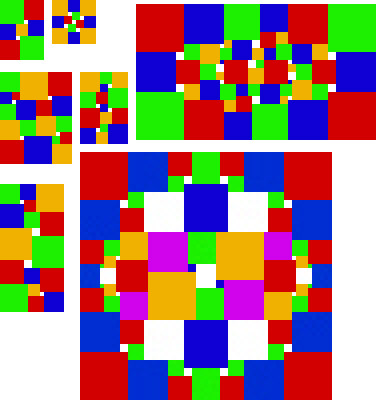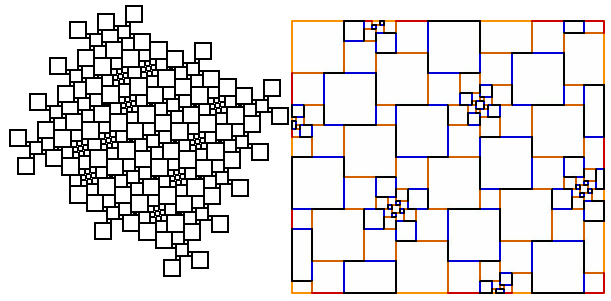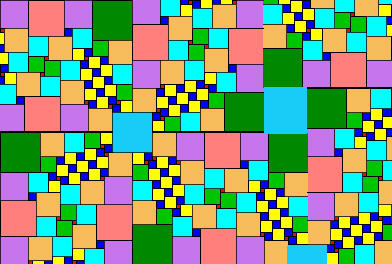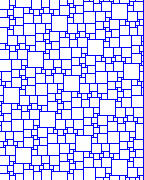 Author
Author |
Topic: Practical Tiling Problem (Read 7039 times) |
|
tohuvabohu
Junior Member
 

Gender: 
Posts: 102
|
 |
Practical Tiling Problem
« on: Aug 28th, 2008, 9:31am » |
 Quote Quote  Modify Modify
|
This isn't the usual type of problem for this forum, it's more aesthetic and open-ended, but I thought someone might take a shot at it.
I'm tiling a bathroom, and I want an original tile pattern. My goal is to use only square tiles, from 1 to 12 inches so that no tile touches another of the same size. I've come up with a couple nice, small, symmetrical designs (9 tiles and 19 tiles) that I may use for the walls surrounding the tub, but for the floor (the main open area is 8'x5') I don't want any obvious repitition.
Parameters:
1. No equal sized tiles lined up next to each other; they can be touching if they're not aligned.
2. Symmetry is okay but not necessary, and I might prefer none (my germinal idea was kind of a cubist version of a fieldstone wall, so symmetry doesn't really fit).
3. Total size does not need to be 8x5. Edge tiles can be truncated squares. (And the missing, truncated part wouldn't necessarily have to give a theoretical straight finished edgeline).
4. A smaller pattern can be repeated if it won't be too obvious.
5. Aesthetics, a good blend of sizes. I keep ending up with a preponderance of big tiles in one area and lots of one and two inch tiles to fill in the holes and finish off the design in another.
6. If you come up with a really nice design, a little violation of rule 1 may be acceptable.
I thought of turning this into some sort of actual puzzle with one correct answer, but if I knew the answer, I wouldn't need to ask for your help. Is there a good algorithm that could maybe start in the center and build outwards in a regular, extendable way that I could use to generate patterns?
|
|
 IP Logged IP Logged |
|
|
|
towr
wu::riddles Moderator
Uberpuzzler
    

Some people are average, some are just mean.
Gender: 
Posts: 13730
|
 |
Re: Practical Tiling Problem
« Reply #1 on: Aug 28th, 2008, 2:56pm » |
 Quote Quote  Modify Modify
|
Maybe you could adapt an approach for aperiodic tiling with Wang tiles (every 'color' would have to be some configuration of (partial) square tiles, that fit together appropriately).
In any case, it won't be less successful than my approaches so far.
|
|
 IP Logged IP Logged |
Wikipedia, Google, Mathworld, Integer sequence DB
|
|
|
tohuvabohu
Junior Member
 

Gender: 
Posts: 102
|
Aperiodic tiling is a little over my head, and over my tiling skills. I'm now thinking that the more symmetrical arrangements look best. Just to clarify what I'm thinking, here are some example tile patterns, ranging from an 11x11 square using only tiles from 1 to 4 units, to a roughly 5 foot near-square that has 2 truncated edge pieces (the middle square on the left and right edges is 5x6).
I really am tiling my bathroom, so if anyone has some better ideas, let me know before I start spreading the grout.
|
|
 IP Logged IP Logged |

|
|
|
towr
wu::riddles Moderator
Uberpuzzler
    

Some people are average, some are just mean.
Gender: 
Posts: 13730
|
 |
Re: Practical Tiling Problem
« Reply #3 on: Aug 29th, 2008, 2:08pm » |
 Quote Quote  Modify Modify
|
on Aug 29th, 2008, 10:13am, tohuvabohu wrote:| Aperiodic tiling is a little over my head, and over my tiling skills. |
|
Just a matter of matching the colors, I think (in the case of wang tiles). They're constructed so that you won't get a periodic pattern. Whether it'll look nice is another matter.
I'd have suggested a penrose tiling if it weren't for the fact you want to use squares of varying sizes.
Quote:| I really am tiling my bathroom, so if anyone has some better ideas, let me know before I start spreading the grout. |
|
And when's that?
|
|
 IP Logged IP Logged |
Wikipedia, Google, Mathworld, Integer sequence DB
|
|
|
tohuvabohu
Junior Member
 

Gender: 
Posts: 102
|
 |
Re: Practical Tiling Problem
« Reply #4 on: Aug 29th, 2008, 5:33pm » |
 Quote Quote  Modify Modify
|
Actually, I'm not dead set on using squares, it was just my first idea for a simple, unique custom tiling. And I'm not at all sure it will look good until I get some tiles in my hands and start making a mock-up.
When? Well, I ordered some tiles that could arrive any time in the next two weeks (. A very natural stone look in four shades, with half the tiles in the lightest shade (I figured the floor would be light, with just a few accent tiles, while the tub surround would be a random mix of all four shades). So my color is set in stone, my pattern is not.
But I'm not a mathematician, I don't want to cut a thousand tiles in very precise angles (like the rhombus tiles require), I don't know how I'd do the colored square aperiodical set without it looking like I just did a whole lot more cutting than was necessary, and I don't really want to have to explain my bathroom so guests can fully appreciate it. I just want something interesting and attractive that hasn't been done before. And simple. Simple is good.
|
|
 IP Logged IP Logged |
|
|
|
tohuvabohu
Junior Member
 

Gender: 
Posts: 102
|
I figured out that I could use my squares of different sizes, with no equals-aligned in a simple infinite tiling, using a fibonacci series of tiles. I would really like this pattern, if it was just a little more complex. Can anyone come up with a slightly more complex infinite tiling?
|
| « Last Edit: Aug 31st, 2008, 9:01pm by tohuvabohu » |
 IP Logged IP Logged |

|
|
|
towr
wu::riddles Moderator
Uberpuzzler
    

Some people are average, some are just mean.
Gender: 
Posts: 13730
|
 |
Re: Practical Tiling Problem
« Reply #7 on: Sep 1st, 2008, 7:05am » |
 Quote Quote  Modify Modify
|
on Aug 30th, 2008, 2:21pm, tohuvabohu wrote:| I figured out that I could use my squares of different sizes, with no equals-aligned in a simple infinite tiling, using a fibonacci series of tiles. |
|
Wait a minute, did you use 13x13 tiles? (1+2=3, 2+3=5, 3+5=8, 5+8=13)
|
|
 IP Logged IP Logged |
Wikipedia, Google, Mathworld, Integer sequence DB
|
|
|
tohuvabohu
Junior Member
 

Gender: 
Posts: 102
|
 |
Re: Practical Tiling Problem
« Reply #8 on: Sep 1st, 2008, 10:04am » |
 Quote Quote  Modify Modify
|
Thanks, that site will be very helpful. I've been trying to come up with a more interesting way to tile the infinite plane. I don't suppose you have a website for that.
And yes, I did use a 13. My original limit of 12 was not to avoid tiles too big, but cutting tiles too small. An inch seemed about the smallest desireable size. If I decided to go that way, 12/13 of an inch is close enough not to reject it. The tiles won't be exact integer sizes anyway, because I need to account for the thickness of the grout lines. I figured I can just print up my own ruler scaled to 12/13, to make measurements simple.
|
|
 IP Logged IP Logged |
|
|
|
towr
wu::riddles Moderator
Uberpuzzler
    

Some people are average, some are just mean.
Gender: 
Posts: 13730
|
I've finally managed to finish a tiling without breaking too many of the rules (I've got one spot with two 3x3 lined up, but it doesn't look too bad)
See attachment.
It's based on your Fibonacci inspired tiling; but I went a step further, and then removed the 13x13 and 21x21 tiles, replacing them with other tiles.
|
|
 IP Logged IP Logged |
Wikipedia, Google, Mathworld, Integer sequence DB
|
|
|
tohuvabohu
Junior Member
 

Gender: 
Posts: 102
|
It is a challenge, and frustrating when it doesn't quite work. I like your design, and don't mind the one touch, except that my bathroom is a bad size for it. The lined up, not quite aligned large tiles, look okay as a large grid, but I think my bathroom is about one and a half pattern wide by and two and a half patterns long. So it would either look like a frame that's not quite the right size or a line cutting my bathroom in half.
It occured to me that there is a much easier way to nowhere-neat, no-fault tile the infinite plane. Take any one of the tilings on the website you found where a corner tile is 6 or less, and combine four copies in a pinwheel, so those 4 sixes become one 12. Add one more squre where the pinwheels combined leave a gap, and you're done.
|
|
 IP Logged IP Logged |

|
|
|
tohuvabohu
Junior Member
 

Gender: 
Posts: 102
|
Or a simpler one with a less noticeable pattern. I have a lot to choose from. Only time and tiles will tell.
|
|
 IP Logged IP Logged |

|
|
|
SMQ
wu::riddles Moderator
Uberpuzzler
    

Gender: 
Posts: 2084
|
 |
Re: Practical Tiling Problem
« Reply #12 on: Sep 3rd, 2008, 8:48am » |
 Quote Quote  Modify Modify
|
For what it's worth, I really like that last one!
--SMQ
|
|
 IP Logged IP Logged |
--SMQ
|
|
|
towr
wu::riddles Moderator
Uberpuzzler
    

Some people are average, some are just mean.
Gender: 
Posts: 13730
|
 |
Re: Practical Tiling Problem
« Reply #13 on: Sep 3rd, 2008, 9:28am » |
 Quote Quote  Modify Modify
|
on Sep 3rd, 2008, 7:59am, tohuvabohu wrote:| Or a simpler one with a less noticeable pattern. |
|
It's quite noticeable across the diagonal.
Maybe someone could write a program to do a pseudorandom tiling.
|
|
 IP Logged IP Logged |
Wikipedia, Google, Mathworld, Integer sequence DB
|
|
|
|
 WRITE MATH!
WRITE MATH!
 Home
Home  Help
Help  Search
Search  Members
Members  Login
Login  Register
Register WRITE MATH!
WRITE MATH!
 Home
Home  Help
Help  Search
Search  Members
Members  Login
Login  Register
Register